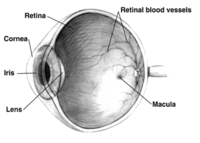
Photo from wikipedia
Abstract. Purpose: Diabetic retinopathy is the leading cause of blindness, affecting over 93 million people. An automated clinical retinal screening process would be highly beneficial and provide a valuable second… Click to show full abstract
Abstract. Purpose: Diabetic retinopathy is the leading cause of blindness, affecting over 93 million people. An automated clinical retinal screening process would be highly beneficial and provide a valuable second opinion for doctors worldwide. A computer-aided system to detect and grade the retinal images would enhance the workflow of endocrinologists. Approach: For this research, we make use of a publicly available dataset comprised of 3662 images. We present a hybrid machine learning architecture to detect and grade the level of diabetic retinopathy (DR) severity. We also present and compare simple transfer learning-based approaches using established networks such as AlexNet, VGG16, ResNet, Inception-v3, NASNet, DenseNet, and GoogLeNet for DR detection. For the grading stage (mild, moderate, proliferative, or severe), we present an approach of combining various convolutional neural networks with principal component analysis for dimensionality reduction and a support vector machine classifier. We study the performance of these networks under different preprocessing conditions. Results: We compare these results with various existing state-of-the-art approaches, which include single-stage architectures. We demonstrate that this architecture is more robust to limited training data and class imbalance. We achieve an accuracy of 98.4% for DR detection and an accuracy of 96.3% for distinguishing severity of DR, thereby setting a benchmark for future research efforts using a limited set of training images. Conclusions: Results obtained using the proposed approach serve as a benchmark for future research efforts. We demonstrate as a proof-of-concept that an automated detection and grading system could be developed with a limited set of images and labels. This type of independent architecture for detection and grading could be used in areas with a scarcity of trained clinicians based on the necessity.
Journal Title: Journal of Medical Imaging
Year Published: 2020
Link to full text (if available)
Share on Social Media: Sign Up to like & get
recommendations!